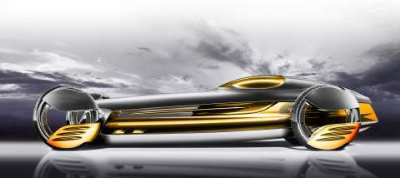|
| ||||
|
Los Angeles Design Challenge: The Mercedes-Benz SilverFlow Can Take on a Wide Variety of Forms
19th November, 2007 | |||
|
A car with extended, elegant lines which can change its form at the touch of a button and adapt to the requirements of its owners at any time – this is the automotive vision that Mercedes-Benz is presenting at the Los Angeles Design Challenge, which is being held for the fourth time as part of the 2007 L.A. Motor Show. When required, this Mercedes of the future can take on the form of a fast highway cruiser, quickly metamorphose into a compact city car, or become a roomy one-seater or economical two-seater, depending on the transport capacity needed. This is made possible by the magnetic control elements of the SilverFlow, a futuristic study by Mercedes-Benz, which take just seconds to configure the car required from tiny metallic particles. The Mercedes-Benz SilverFlow is among the highlights of the Los Angeles Design Challenge, in which eight car design studios in southern California were given the assignment to design the "Robocar 2057" as a combination of vehicle technology and artificial intelligence. Accordingly, the Mercedes-Benz Advanced Design Centre of North America in Irvine, California, which is headed by Gorden Wagener, looked 50 years into the future and came up with the shimmering silver and gold Vision SilverFlow car. With its long, flowing lines and narrow, exposed wheels, this vision of the future is highly reminiscent of the golden years in motor racing during the 1930s. In fact the physical characteristics of the SilverFlow are even more exciting than its shape. It consists of billions of microscopically tiny metallic particles which are formed into variable but stable configurations by magnetic fields. This means that the driver can perfectly adapt the vehicle to its intended purpose. The one-seater highway configuration is extremely aerodynamic, while the city version is short and spacious. The pre-programmed vehicle variants can be selected at any time at the touch of a button, whereupon the assembler electronics reshape the car from one form to another within a few seconds – specialists refer to this as 'morphing'. Any desired shape is available in principle. As a particularly convenient feature when parking, the intelligent control system completely disassembles the vehicle structure and compacts the ferro-magnetic particles into a small, space-saving configuration. And thanks to these flexible metallic particles, dents and paint damage are also a thing of the past. The disadvantage of the Mercedes-Benz SilverFlow is that, so far, it only exists as a two-dimensional graphic design. The SilverFlow study, which – if at all – will only be realisable decades into the future, clearly shows that while car designers certainly live in the present, their working environment is the future. Professor h.c. Peter Pfeiffer, Senior Vice President Mercedes-Benz Design: "The Los Angeles Design Challenge is certainly a creative challenge with this futuristic concept. The SilverFlow reflects our successful motor sports history, while boldly suggesting innovative solutions for the individual mobility of coming generations." Mercedes-Benz has established Advanced Design Studios in the USA, Japan, Italy and Sindelfingen to look well into the future and engage in stylistic research for the cars of tomorrow. The task of the designers is above all to be receptive to current signals from other cultures and incorporate these into Mercedes-Benz design. | ||||
ABN 47106248033 |
 |
All rights reserved. |
